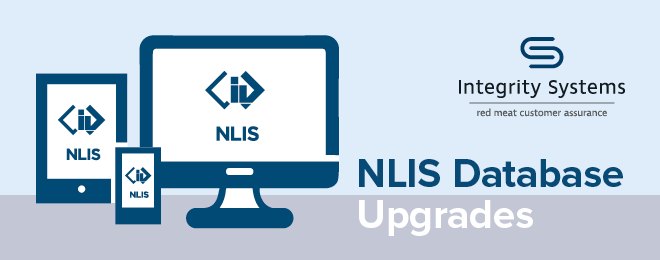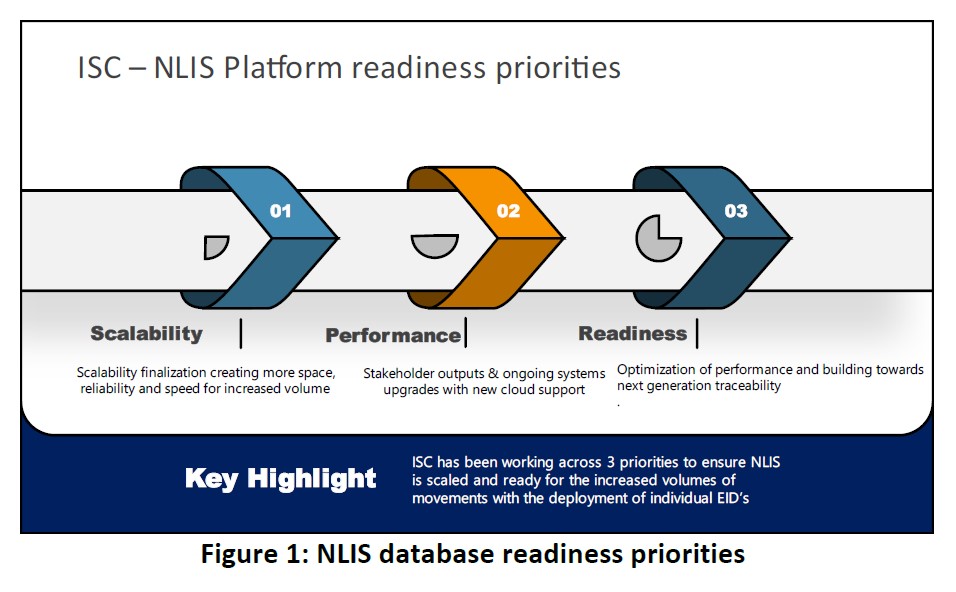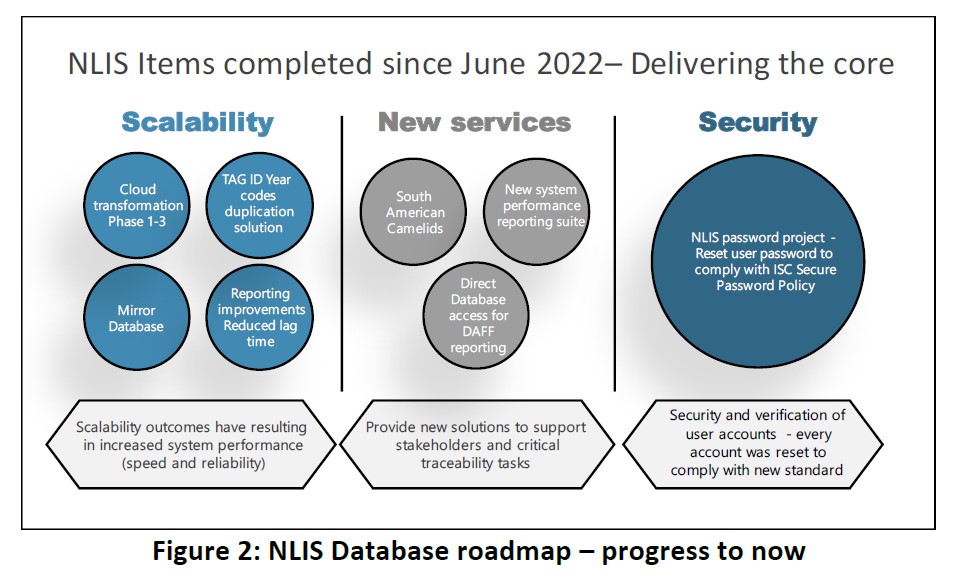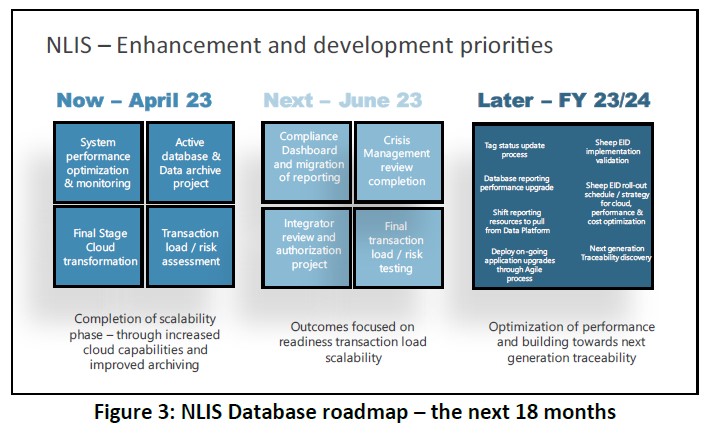NLIS Database Uplift Project

Key points
• The NLIS database is functionally ready to support the national rollout of individual electronic identification (eID) of sheep and goats.
• A range of enhancements are being implemented across the NLIS database to ensure that is scalable to support the increased volumes of individual livestock movements and that it continues to perform critical traceability tasks under an expected increased load.
• ISC has prepared a draft Grant proposal for consideration by the Australian Government to support the build of a new traceability platform to uplift and replace the current NLIS database. If the Grant is supported, scoping is planned to commence in the first half of 2023.
Introduction
The National Livestock Identification System (NLIS) database is a vital asset for the red meat and livestock industry and the state and federal governments of Australia. As a key enabler of red meat traceability, biosecurity and market access, investment in the NLIS database is crucial for our industry to manage and respond to biosecurity risks and market access demands, both now and into the future. The NLIS database was established in 1999 to support the cattle industry in meeting market access requirements into the European Union. The NLIS database has evolved over the last 23 years to support the mandatory introduction of NLIS in cattle, sheep and goats, and has been expanded to incorporate the traceability data of pigs and, more recently, South American camelids.
While the NLIS database is delivering on its core purpose and will continue to meet its required mandate of underpinning livestock traceability, the current technology is complex, difficult to maintain and challenging to upgrade. This limits the ability to deliver a user-friendly and streamlined experience for users and means that enhancements can take considerable time to implement. With the announcement of funding for NLIS database upgrades in the 2022-23 federal budget, ISC is currently preparing a funding Grant proposal for the scoping and build of a new traceability platform that will replace the current NLIS database.
Planned upgrades to the existing NLIS database
A detailed roadmap has been developed for system upgrades to the current NLIS database, with implementation well underway. ISC has been working across three priority areas (scalability, performance and readiness) to ensure the NLIS database is scaled and ready for the increased volumes of movements that will be seen as states progress to a national implementation of sheep and goat eID (see Figure 1).
In progressing the roadmap, a range of activities have been completed since June 2022 (see Figure 2) including reporting improvements, security upgrades, and several backend and infrastructure enhancements to increase speed and reliability. Further work is planned over the coming 18 months to ensure the NLIS database continues to meet the traceability needs of industry and government
(see Figure 3).


New traceability platform build
In the October 2022-23 Budget, the federal Government announced funding to support traceability database upgrades (NLIS) as part of the biosecurity package 'Bolstering Australia's biosecurity system'.
In late 2022, ISC commenced discussions with the Department of Ariculture, Fisheries and Forestry (DAFF) regarding this funding and a Grant proposal has now been prepared by ISC for DAFF consideration, for the build of a new traceability platform to replace the current NLIS database.
The build of a new national livestock traceability database will ensure that there is a fit-for-purpose data capture, storage and distribution system for tracking livestock and their movements well into the future. A new platform would be designed to be flexible and scalable to support not only the expected growth under a national implementation of electronic identification (eID) for sheep and goats but would also provide an important vehicle to support current and future red meat market access requirements. If approved, the Grant would fund a three-year project for the scoping, design and build of a new livestock traceability platform, with the project to commence in the first half of 2023.
Taking a user-centred design approach, the platform scoping and design phase would consider current pain points across the supply chain and consider how these could be addressed as part of the new system build or through other mechanisms. While the priority for the new platform will be to accommodate all FMD susceptible livestock species (including cattle, sheep, goats, pigs and south American camelids), the design principles will consider how the platform could expand to accommodate the traceability needs of other commodities. The project will work to balance the mutual needs of industry and government in supporting and strengthening livestock biosecurity, food safety and market access (the needs of today), while also considering future market and customer requirements (the needs of tomorrow).
Governance and scope will be the early priorities to ensure initial and ongoing inputs into the design elements of the platform and its deployment. Industry, government and other key stakeholders would be kept informed of progress and engaged through reference groups and workshops through each phase of the project. Change management, communication and adoption activities would be conducted simultaneously throughout the project to align with project objectives and stakeholder needs.
NLIS Database readiness to support national rollout of eID for sheep and goats
In September 2022 all Australian Agriculture Ministers agreed to work with industry towards the implementation of mandatory individual electronic identification (eID) for sheep and goats in each jurisdiction by 1 January 2025. States and territories are now working on the development of their detailed implementation plans to underpin the national rollout, which will be based around a targeted implementation date of 1 January 2025.
The proposed NLIS upgrades will support the national rollout. Enhancements to the existing NLIS database are being prioritised to ensure support of the increased volumes of individual livestock movements and that it continues to perform critical traceability tasks under an expected increased load.
Where does eNVD fit?
A soft launch of the eNVD mobile app occurred on 30 November 2022. The soft launch allowed ISC to assess the performance of the app in the field and to ensure any issues were ironed out before embarking on a significant communication campaign. On 21 March 2023 a comprehensive communication program commenced to drive producer uptake of the app. Since its launch in November there have been close to 7,000 downloads of the app and more than 90,000 livestock movements accompanied by a digital NVD created through the app. Simultaneously, work continues on supply chain readiness and adoption to ensure the acceptance and uptake of digital consignments from farm through to processing.
The eNVD is an important component of the integrity system that aims to improve the accuracy and completeness of movement documentation, while creating efficiencies and removing duplication of effort through the supply chain. Work will continue in 2023 on the eNVD app and the web-based eNVD platform to improve the alignment between the two, and to introduce new functionality like workflows, comments and split consignments. Importantly, scoping will commence for how NLIS movement recording can be integrated into the eNVD, to create a more seamless experience for producers in complying with their traceability requirements.

